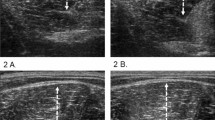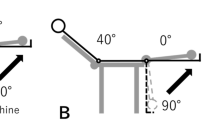Abstract
This study was designed to determine the regional differences of magnetic resonance (MR) measurements in the hamstrings [biceps femoris muscle long head (BFl) and short head (BFs), semimembranosus muscle (SM), and semitendinosus muscle (ST)] following eccentric knee-flexion exercise. Twelve male volunteers performed eccentric knee-flexion exercise. Maximum isometric torque, plasma creatine kinase (CK) activity, muscle soreness, and MR images of the hamstrings were measured before and immediately following exercise, and on the first, second, third and seventh days following the exercise. Cross-sectional areas (CSAs) and transverse relaxation times (T2s) of the hamstrings were measured from the T2-weightened MR imaging sequences of 30% (proximal), 50% (middle), and 70% (distal) areas of the thigh length. The CSA of the ST at proximal and middle regions had significantly increased on the third day, but no significant changes were found for the BFl or SM. Immediately following exercise, T2 values had increased significantly in the BFs, BFl, and ST. On the third day, T2 values of only ST increased significantly at proximal, middle and distal regions. Significant differences of T2 values between proximal and distal regions in the ST were found for the second, third and seventh days following the exercise. These results suggest that because of the anatomical characteristics of the muscles, the degrees of response following the exercise differed among the muscles and the regions of ST muscle.





Similar content being viewed by others
References
Adams GR, Duvoisin MR, Dudley GA (1992) Magnetic resonance imaging and electromyography as indexes of muscle function. J Appl Physiol 73:1578–1583
Akima H, Takahashi H, Kuno SY, Katsuta S (2004) Coactivation pattern in human quadriceps during isokinetic knee-extension by muscle functional MRI. Eur J Appl Physiol 91:7–14
Askling CM, Tengvar M, Saartok T, Thorstensson A (2007) Acute first-time hamstring strains during high-speed running: a longitudinal study including clinical and magnetic resonance imaging findings. Am J Sports Med 35:197–206
Baczkowski K, Marks P, Silberstein M, Schneider-Kolsky ME (2006) A new look into kicking a football: an investigation of muscle activity using MRI. Australas Radiol 50:324–329
Chen TC, Nosaka K, Sacco P (2007) Intensity of eccentric exercise, shift of optimum angle, and the magnitude of repeated-bout effect. J Appl Physiol 102:992–999
Clarkson PM, Hubal MJ (2002) Exercise-induced muscle damage in humans. Am J Phys Med Rehabil 81:S52–S69
Connell DA, Schneider-Kolsky ME, Hoving JL, Malara F, Buchbinder R, Koulouris G, Burke F, Bass C (2004) Longitudinal study comparing sonographic and MRI assessments of acute and healing hamstring injuries. AJR Am J Roentgenol 183:975–984
Friederich JA, Brand RA (1990) Muscle fiber architecture in the human lower limb. J Biomech 23:91–95
Garrett WE Jr, Nikolaou PK, Ribbeck BM, Glisson RR, Seaber AV (1988) The effect of muscle architecture on the biomechanical failure properties of skeletal muscle under passive extension. Am J Sports Med 16:7–12
Harrison BC, Robinson D, Davison BJ, Foley B, Seda E, Byrnes WC (2001) Treatment of exercise-induced muscle injury via hyperbaric oxygen therapy. Med Sci Sports Exerc 33:36–42
Heiderscheit BC, Hoerth DM, Chumanov ES, Swanson SC, Thelen BJ, Thelen DG (2005) Identifying the time of occurrence of a hamstring strain injury during treadmill running: a case study. Clin Biomech (Bristol, Avon) 20:1072–1078
Jayaraman RC, Reid RW, Foley JM, Prior BM, Dudley GA, Weingand KW, Meyer RA (2004) MRI evaluation of topical heat and static stretching as therapeutic modalities for the treatment of eccentric exercise-induced muscle damage. Eur J Appl Physiol 93:30–38
Jenner G, Foley JM, Cooper TG, Potchen EJ, Meyer RA (1994) Changes in magnetic resonance images of muscle depend on exercise intensity and duration, not work. J Appl Physiol 76:2119–2124
Kinugasa R, Kawakami Y, Fukunaga T (2006) Quantitative assessment of skeletal muscle activation using muscle functional MRI. Magn Reson Imaging 24:639–644
Koulouris G, Connell D (2006) Imaging of hamstring injuries: therapeutic implications. Eur Radiol 16:1478–1487
Larsen RG, Ringgaard S, Overgaard K (2007) Localization and quantification of muscle damage by magnetic resonance imaging following step exercise in young women. Scand J Med Sci Sports 17:76–83
LeBlanc AD, Jaweed M, Evans H (1993) Evaluation of muscle injury using magnetic resonance imaging. Clin J Sport Med 3:26–30
Lee TC, O’Driscoll KJ, McGettigan P, Moraes D, Ramphall S, O’Brien M (1988) The site of the tendinous interruption in semitendinosus in man. J Anat 157:229–231
Lieber RL, Bodine-Fowler SC (1993) Skeletal muscle mechanics: implications for rehabilitation. Phys Ther 73:844–856
Lieber RL, Friden J (2000) Functional and clinical significance of skeletal muscle architecture. Muscle Nerve 23:1647–1666
Nosaka K, Sakamoto K (2001) Effect of elbow joint angle on the magnitude of muscle damage to the elbow flexors. Med Sci Sports Exerc 33:22–29
Prior BM, Jayaraman RC, Reid RW, Cooper TG, Foley JM, Dudley GA, Meyer RA (2001) Biarticular and monoarticular muscle activation and injury in human quadriceps muscle. Eur J Appl Physiol 85:185–190
Schwane JA, Buckley RT, Dipaolo DP, Atkinson MA, Shepherd JR (2000) Plasma creatine kinase responses of 18-to 30-yr-old African-American men to eccentric exercise. Med Sci Sports Exerc 32:370–378
Segal RL, Song AW (2005) Nonuniform activity of human calf muscles during an exercise task. Arch Phys Med Rehabil 86:2013–2017
Sesto ME, Radwin RG, Block WF, Best TM (2005) Anatomical and mechanical changes following repetitive eccentric exertions. Clin Biomech (Bristol, Avon) 20:41–49
Thelen DG, Chumanov ES, Hoerth DM, Best TM, Swanson SC, Li L, Young M, Heiderscheit BC (2005) Hamstring muscle kinematics during treadmill sprinting. Med Sci Sports Exerc 37:108–114
Tidball JG, Salem G, Zernicke R (1993) Site and mechanical conditions for failure of skeletal muscle in experimental strain injuries. J Appl Physiol 74:1280–1286
Vandenborne K, Walter G, Ploutz-Snyder L, Dudley G, Elliott MA, De Meirleir K (2000) Relationship between muscle T2* relaxation properties and metabolic state: a combined localized 31P-spectroscopy and 1H-imaging study. Eur J Appl Physiol 82:76–82
Wickiewicz TL, Roy RR, Powell PL, Edgerton VR (1983) Muscle architecture of the human lower limb. Clin Orthop Relat Res 179:275–283
Woodley SJ, Mercer SR (2005) Hamstring muscles: architecture and innervation. Cells Tissues Organs 179:125–141
Acknowledgments
The authors gratefully acknowledge N. Tawara and Y. Iwahara for their technical assistance to this research. We also thank the Japan Institute of Sports Sciences. This work was supported by Basic Research (B) (19650179) in 2007 and 2008.
Author information
Authors and Affiliations
Corresponding author
Rights and permissions
About this article
Cite this article
Kubota, J., Ono, T., Araki, M. et al. Non-uniform changes in magnetic resonance measurements of the semitendinosus muscle following intensive eccentric exercise. Eur J Appl Physiol 101, 713–720 (2007). https://doi.org/10.1007/s00421-007-0549-x
Accepted:
Published:
Issue Date:
DOI: https://doi.org/10.1007/s00421-007-0549-x




